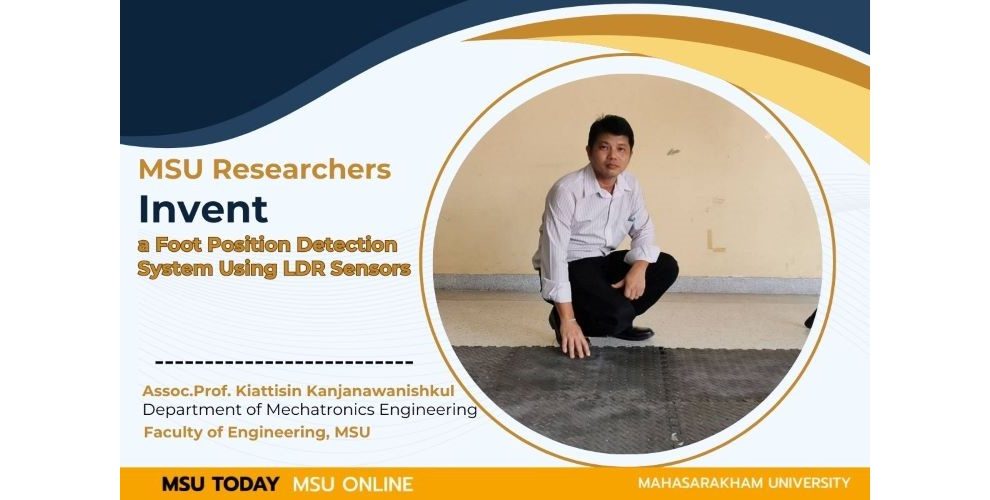MSU Researchers Invent Foot Position Detection System Using LDR Sensors
Researchers at MSU invented a foot position detection system on areas equipped with LDR sensors as part of a walking training process for rehabilitation and enhancing the ability to control the body for patients with diseases affecting the brain, spinal cord, nerves, or leg injuries, enabling them to walk safely again. The system is developed under the supervision of Assoc.Prof. Kiattisin Kanjanawanishkul, a lecturer in the Department of Mechatronics Engineering, Faculty of Engineering, MSU.

Title of the Work
Foot Position Detection System on Areas Equipped with LDR Sensors
Research Background
Walking training is part of the physical rehabilitation process to improve bodily control for patients with diseases affecting the brain, spinal cord, nerves, or leg injuries, enabling them to walk again. This process involves learning how to walk under the supervision of a physiotherapist or rehabilitation specialist. During the training, physical therapists aim to assess foot contact, weight distribution symmetry between both sides, step length, and walking speed. Currently, physiotherapists assess patients through observation and experience, which can lead to errors and impact the planning of the training. Therefore, developing a foot position detection system helps physiotherapists evaluate walking training accurately and in real time.
Another application of the foot position detection system is the assessment of the capabilities of children, the elderly, or athletes. For example, footstep training in primary school children is crucial for physical and mental development, as it improves balance and responsiveness. In athletes, the system can be used to train movement and rapid direction changes, enhancing neuromuscular coordination. In the case of the elderly, there is a stepping exercise program consisting of walking slowly in the forward, sideways, back and diagonal directions.

Usage of the Foot Detection Pads
The developed system consists of two parts: the foot placement detection pad and a computer for processing, equipped with analysis and display software. Each pad has a unique identifier for referencing and retrieving data into the program. The foot placement detection pad is made from lightweight EVA foam, with each pad measuring 60 cm x 60 cm and approximately 2.5 cm thick. The edges of each pad are designed like jigsaw pieces for easy assembly, allowing the walking surface area to be expanded. The sensors used for foot placement detection are LDR (Light Dependent Resistor) sensors. Each pad contains an 11 x 11 grid of LDR sensors, spaced 5.6 cm apart, to cover the foot placement area. The voltage output from each sensor circuit varies depending on whether a foot is present or not, enabling accurate detection of the foot’s position.
Data from each pad is transmitted to a Raspberry Pi computer. The program then converts the sensor data into an image displayed on a screen, resembling a footprint. Users can directly observe the foot position and step distance, with alerts if the step length is incorrect.

Key Advantages of the Foot Detection Pad Research
This research is unique in the following ways:
(1) It uses LDR sensors, which are widely available and inexpensive.
(2) The foot detection pads can be expanded in number and arranged in different configurations.
(3) The pads are portable and easy to store.
Challenges and obstacles in the project:
Each pad requires the installation of 121 sensors, and grooves must be cut into the pad to install and connect small wiring circuits. This process takes considerable time to complete one pad.

Future Plans for Community Implementation
The research is in the stage of increasing the number of pads and testing the system. Once ready, it will be tested in two groups:
(1) The rehabilitation and physiotherapy departments at Mahasarakham Hospital, where it will be used with patients undergoing walking training.
(2) Subdistrict health promoting hospitals, where it will be used to assess the capabilities of the elderly in the community.
Future Research Developments
The system will be expanded from the current 6 pads to 15-20 pads, allowing for different configurations. Additionally, an analysis of walking speed will be added.

Message to Young Researchers on Inventing Useful Tools for Society and Communities
Researchers often seek research problems, but in reality, every profession and community is a source of research problems. The key is to reach out and understand these problems. If we can solve issues for communities or businesses, it will benefit not only ourselves but everyone involved.
Original Thai Article: https://news.msu.ac.th/msumagaz/smain/readpost.php?mid=581



Leave a Reply